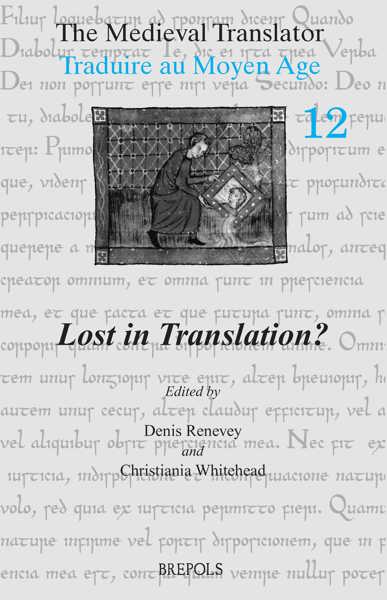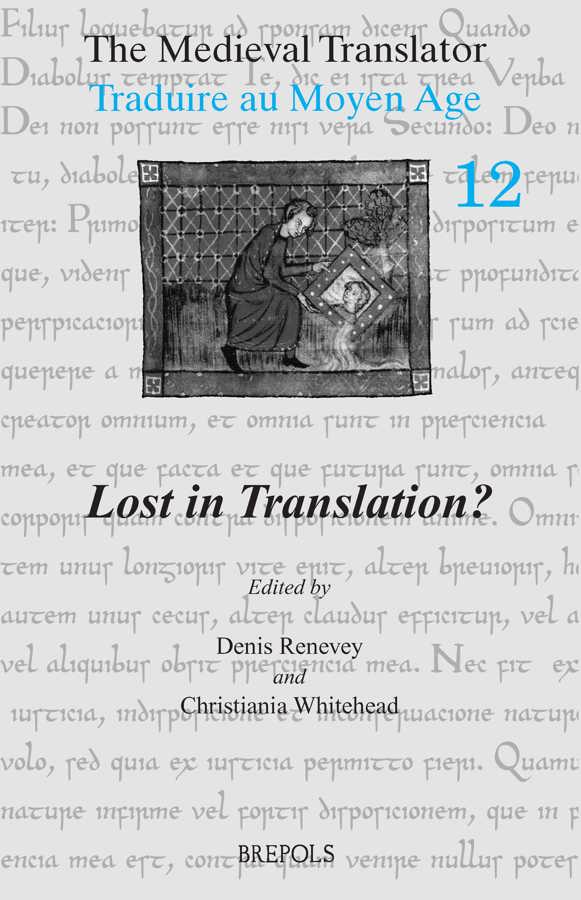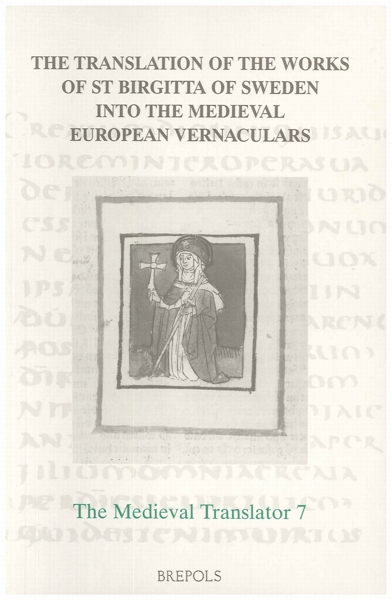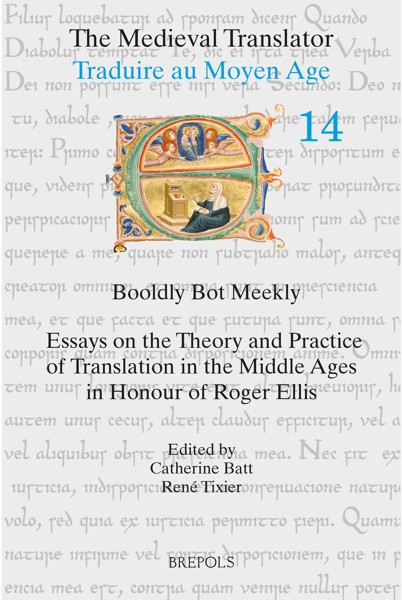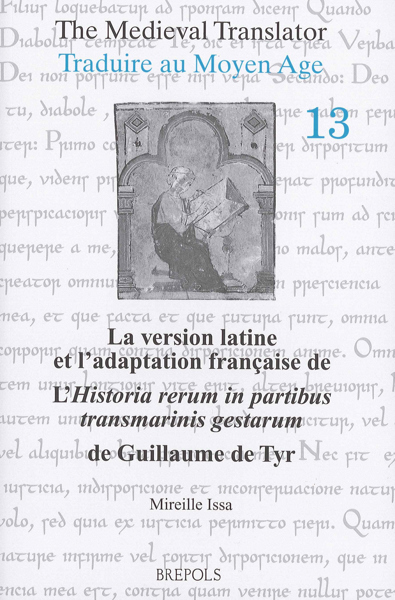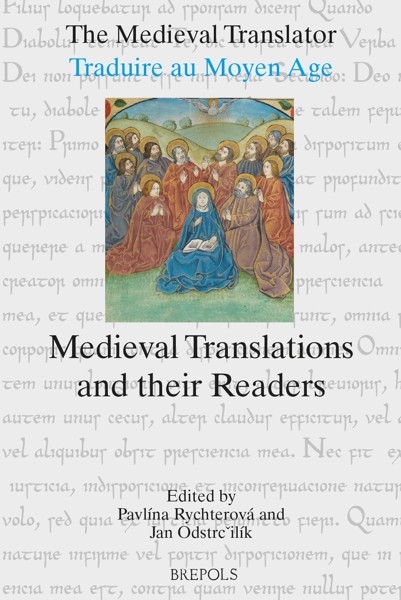
- Pages: 382 p.
- Size:150 x 230 mm
- Illustrations:38 b/w
- Language(s):French, English
- Publication Year:2010
- € 55,00 EXCL. VAT RETAIL PRICE
- ISBN: 978-2-503-53139-7
- Paperback
- Available
- € 55,00 EXCL. VAT RETAIL PRICE
- ISBN: 978-2-503-53982-9
- E-book
- Available
The contributions to this volume are organised in a way that bear out the vitality of translation activity in the medieval period and the resourcefulness of modern scholarship in addressing the phenomenon of translation at large. No other period relies so heavily on this literary process to construct its cultural identity. Translations from Latin into the vernacular, or from one vernacular into another, or even from a vernacular into the Latin language, are just a few of the many forms medieval translation can take. The codification of the translation process as appropriation, transformation, or accommodation does not sufficiently emphasize the overarching curiosity and interest that motivates any translation activity. Rather, preceding the stages of appropriation and re-interpretation, it is positive inquisitiveness and openness towards linguistic and cultural difference that generate the production of a new text and the transference of culture from one sphere to another. Translation practice creates a dialogic exchange between cultures, it recognises difference and diversity, both linguistic and cultural, yet it also shapes its new product for the use of an audience or readership that is concurrently aware of the reciprocal need to participate in that exchange, in order to improve its own culture. It is that positive inquisitiveness which this volume emphasizes.
The volume initially addresses the way in which translators dealt with texts from the early medieval period. It then considers the phenomenon of bilingualism and the privileged relationship that England held with the continent, especially the Italian and French literary traditions. The third part of this volume tackles the problem of fifteenth-century religious translation in England and, to a lesser extent, France, and complicates it by showing its inevitable political implications. Understood more particularly as an act of cultural transfer, translation activity can also be considered beyond the linguistic process. The fourth part of the volume deals with several instances of translations from one genre into another, and from one media into another. The contributions to this volume provide some answers to conundrums in the theory and practice of translation encountered during the medieval period. They also point to new ways of considering this literary process, and by praising diversity and difference, they suggest a less traumatic way of reading Babel than is usually implied.
Les communications présentées dans ce volume témoignent, par leur agencement, de la vitalité de l’activité de traducteur au cours de la période médiévale, ainsi que de l’inventivité de la recherche actuelle dans l’étude de la traduction en général. Aucune autre période ne semble autant dépendre de ce procédé littéraire pour la construction de son identité culturelle. Les traductions du latin vers une langue vernaculaire, ou d’une langue vernaculaire vers une autre, ou encore d’une langue vernaculaire vers le latin, constituent quelques-unes des nombreuses formes de la traduction au Moyen Âge. La codification du processus de traduction en tant qu’appropriation, transformation ou accommodation, fait insuffisamment ressortir le rôle essentiel de la curiosité et de l’intérêt qui sont à l’origine de tout acte de traduction. C’est cette curiosité positive que le présent volume cherche à mettre en valeur.
Il aborde tout d’abord une étude de la traduction de textes du haut Moyen Âge. Il considère ensuite le phénomène du bilinguisme et la relation privilégiée que l’Angleterre entretient avec le continent, en particulier avec les traditions littéraires française et italienne. Une troisième partie, consacrée à la traduction des textes religieux au quinzième siècle en Angleterre, et dans une moindre mesure en France, met en évidence la dimension politique de l’activité de traduction à cette période. Considérée principalement comme transfert culturel, la traduction peut en effet être abordée au-delà de sa dimension purement linguistique. Une quatrième partie présente plusieurs exemples de traduction d’un genre littéraire vers un autre, d’un média vers un autre. Les communications proposées dans ce volume illustrent également des manières nouvelles d’aborder l’entreprise essentiellement littéraire de la traduction. Tout en faisant l’éloge de la diversité et de la différence, elles suggèreront une lecture de l’épisode de Babel moins traumatisante que ce qui en est généralement retenu.
Acknowledgements
Notes about the Contributors
Abbreviations
Introduction
Part One: The Early Tradition
Colette Stevanovitch, Translating Old English Poetry: What about Grammar? – Winfried Rudolf, The Old English Translations of the Verba Seniorum in Late Eleventh-Century Worcester – Siân Grølie, Translating (and Translocating) Miracles: Gregory’s Dialogues and the Icelandic Sagas – Jennifer N. Brown, ‘Cut from Its Stump’: Translating Edward the Confessor and the Dream of the Green Tree – Marsha L. Dutton, Negative Capability in the Study of Early Printed Texts: Aelfred of Rievaulx’s Vita Sancti Edwardi in the Gilte Legende and in Caxton’s Golden Legende
Part Two: Bilingualism and Continental Culture
Domenico Pietropaolo, Dante on Translation – Piero Boitani, Chaucer Translates from Italian – Thomas Gibson Duncan, Lords and Brothels: Aspects of Bilingualism in the Middle English Mirror – Alessandra Petrina, Excuse my French: Bilingualism and Translation in Lancastrian England – Jonathan Hsy, Translation, Suspended: Literary Code-Switching and Poetry of Sea Travel – Margaret Connolly, When the Right Word Really Matters: Practical Translation in a Fifteenth-Century Leechbook – Caroline Boucher et Jean-Pascal Pouzet, La Matière des Echecs amoureux, d’Evrart de Conty à Reson and Sensuallyte – Ludmila Evdokimova, Le Prologue du Livres Flave Vegece de la chose de chevalerie et la question de son attribution
Part Three: Fifteenth-Century Religious Culture
Alastair J. Minnis, ‘Oonly consent of love is sufficient for matrimonie’: Translating John Wyclif’s Word of the Mind – Michael G. Sargent, Nicholas Love’s Mirror of the Blessed Life of Jesus Christ and the Politics of Vernacular Translation in Late Medieval England – Ian Johnson, The Non-Dissenting Vernacular and the Middle English Life of Christ: The Case of Love’s Mirror – Anne Elisabeth Mouron, The Livre de l’instruction du cuer de l’ame devote: A Medieval French Translation of De doctrina cordis – Stephanie Morley, Translating Lady Margaret Beaufort: A Case of Translation as Compensatory Power
Part Four: Beyond Translation
Stephanie Seavers, From Idea to Image: A Visual Translation of the Aerial Flight of Alexander the Great – Juliana Dresvina, St Cinderella, a Virgin Martyr: Literary and Iconographic Translations of the Legend of St Margaret of Antioch – Sabina Zonno, Illumination Translates: The Image of the Castle in Some Fourteenth-Century English Manuscripts – Catherine Batt, ‘Translations’ of the Girdle: Cultural and Devotional Signs in Fourteenth-Century England – Monica Santini, A Knight Errant in the Seventeenth Century: Tom a Lincoln and Medieval Romance – James F. Knapp and Peggy A. Knapp, Found in Translation – Fulvio Ferrari, From Saga to Comics: Njáls Saga and the Graphic Novels of Embla Yr Bárudóttir and Ingólfur Örn Björgvinsson
Select Bibliography
Index
